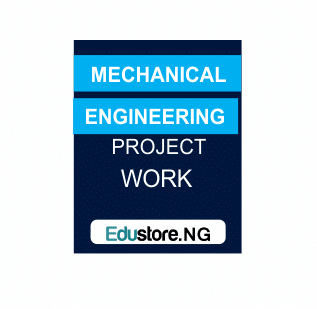ABSTRACT
Using a specially designed tensile testing rig a stress-strain curve of cobwebs produced by known species of spiders, was generated. The mechanical properties of the cobweb were found to be a function of the age of the silk, thus for the youngest cobweb the tensile strength (TS) was 2.33×109N/m2 and for the oldest cobweb it was 2.21×109 N/m2. The modulus of elasticity for the youngest cobweb was 1.03 x 109 N/m2 while for the oldest it was 2.43×108 N/m2. The tensile strength values from the study compared favourably with literature in which were reported for youngest cobweb the TS was 2.33 x 109N/m2 and for the oldest it was 2.21×108N/m2. From this study also the breaking strength of the youngest cobweb of 2.33×109N/m2 compared slightly favourably well with the breaking strength of 1.6×109N/m2 of black widow cobweb from literature.
The mechanical properties of the spiders cobwebs calculated from the stress-strain curve of the spider’s cobwebs from this study suggest that spiders cobweb is a potential material for application in engineering and medicine.
TABLE OF CONTENTS
Title Page………………………………………………………………….. i
Certification………………………………………………………………… ii
Acknowledgement…………………………………………………………. iii
Abstract……………………………………………………………………… iv
Table of Contents…………………………………………………………… vi
List of Tables……………………………………………………………….. vii
List of Figures………………………………………………………………. ix
List of Symbols……………………………………………………………… xi
CHAPTER ONE
1.1 Introduction…………………………………….……………………. 1-2
CHAPTER TWO
- Literature Survey…………………………………………………… 3-8
CHAPTER THREE
- Materials and Methods…………………… ……………..……… 9-15
- Materials……………………………………………………..….… 9
- Identification and collection… ………………….……. 9-10
- Sampling……………………………………………..….. 11
- Methods……………………………………………………..…. 11-15
- Design features, construction and calibration………… 12
- Test Rig calibration……………………..………………. 12
- Equipment………………………………………..…… 12-14
- Testing…………………………………………………. 14-15
- Materials……………………………………………………..….… 9
Chapter Four
- Results and Analysis…………………….……………… 16-41
- Results………………………………………….…….. 16-24
- Raw load extension data of different
- Results………………………………………….…….. 16-24
categories of spider cobweb………..……….. 16-17
- Normalized data of different Categories of Cobweb………………………………………… 18-19
- Stress-Strain Values for Different
Categories of Cobweb….………..………. 20-21
- Stress-Strain Values of cotton wool treated with
Decane, Amorphous Cotton wool and DHFRP..… 22-24
Stress-strain curves………………………….……. 25-29
Calculated Mechanical Properties……………..….. 31-33
Mechanical Properties of all the materials used….. 34-36
- Analysis of results……………………………………. 37-41
- Conclusion………………………………………….… 42-43
References………………………………………… 44
Appendices………………………………………. 45-59
CHAPTER ONE
INTRODUCTION
- BACKGROUND INFORMATION
Spiders are a specific class of animals called arachnids that range in size from the small jumping spiders commonly seen in residential areas to the goliath bird eater tarantula of South Africa (the largest spider in the world). They differ from insects because they have two body parts and eight legs.
Formal categorizations of spiders start by placing them in families, based on specific criteria, viz:
- Eating habits
- Shape and form of cobwebs
There are varieties of hunting spiders such as the crab spiders, fishing spiders and jumping spiders, which are often found in and around residential areas. Spiders bite and the bite of a few spiders is fatal. Many common spiders are beneficial because they feed on pests.
Natural and synthetic spider cobwebs are used in many products including bullet proof materials, speciatly textile, artificial tendons, sutures and other engineering and medical applications. The mechanical and structural properties of the cobweb silk dictate the performance and longevity of these products in which they are used and the measurement of these properties is essential for their engineering and medical applications.
DOWNLOAD COMPLETE WORK- For Reference Only: Materials are for research, citation, and idea generation purposes and not for submission as your original final year project work.
- Avoid Plagiarism: Do not copy or submit this content as your own project. Doing so may result in academic consequences.
- Use as a Framework: This complete project research material should guide the development of your own final year project work.
- Academic Access: This platform is designed to reduce the stress of visiting school libraries by providing easy access to research materials.
- Institutional Support: Tertiary institutions encourage the review of previous academic works such as journals and theses.
- Open Education: The site is maintained through paid subscriptions to continue offering open access educational resources.




